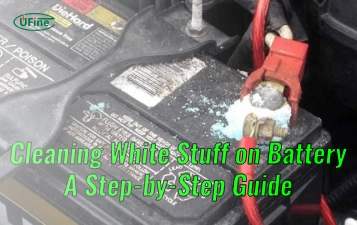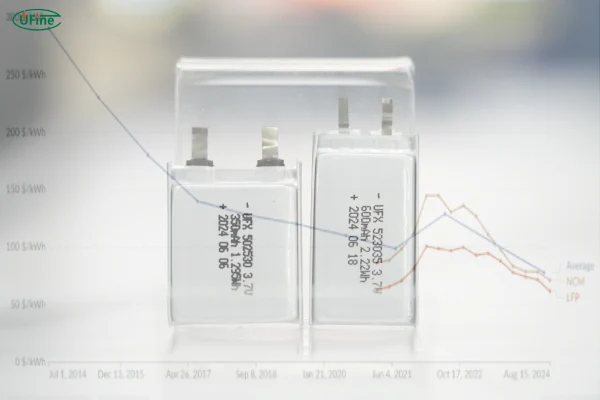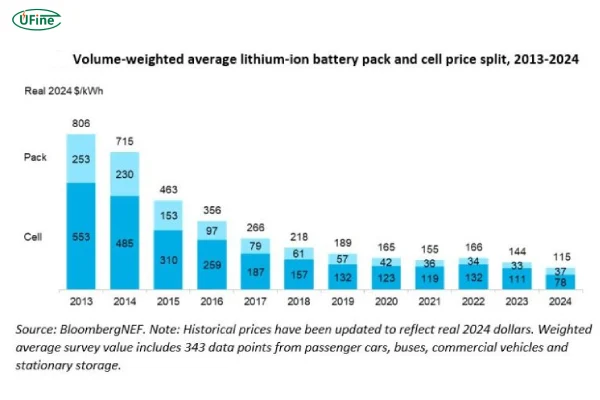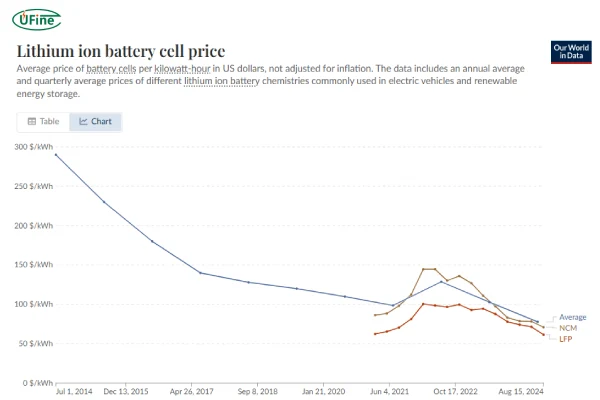In an era where electric vehicles, portable electronics, and renewable energy storage are booming, the li-ion cell price has become a crucial point of discussion across industries. As demand surges globally, understanding how these prices are set—and what’s driving them—is essential for manufacturers, suppliers, and consumers alike.
In this article, we’ll break down the latest pricing trends, contributing factors, regional differences, and future outlooks for lithium-ion cell prices in 2025.
Part 1. What is a li-ion cell? A quick refresher
A lithium-ion (Li-ion) cell is a type of rechargeable battery cell known for its high energy density, lightweight design, and rechargeability. These cells power a wide array of modern devices, from smartphones and laptops to electric vehicles (EVs) and solar power systems.
Li-ion cells come in several formats:
- Cylindrical cells (e.g., 18650, 21700)
- Prismatic cells
- Pouch cells
Cylindrical VS Prismatic VS Pouch Cells
Each form has its own applications and cost implications. For example, 18650 cells are widely used in power tools and e-bikes due to their affordability and efficiency.
Part 2. Average li-ion cell price in 2025
As of Q1 2025, the average li-ion cell price is around $85 per kilowatt-hour (kWh) at the pack level, down from $101/kWh in 2022, according to BloombergNEF. For individual cells, prices vary significantly:
- 18650 cylindrical cells: $1.20 – $2.00 per cell
- 21700 cells: $2.00 – $3.50 per cell
- Pouch cells: $90 – $130 per kWh (bulk pricing)
21700 vs 18650 Battery:What Difference is between them?
Prices are also affected by order volume. Bulk and OEM contracts can push prices much lower than retail offerings.
Part 3. Key factors influencing li-ion cell prices
Several elements directly impact the li-ion cell cost:
a. Raw Materials
Lithium, cobalt, nickel, and graphite make up the core components of li-ion cells. In 2024, lithium carbonate prices fell to around $14,000 per ton, down from over $70,000/ton in 2022, due to increased supply from new mines in China and South America.
b. Manufacturing and Technology
Automation, vertical integration, and AI-driven production are reducing costs. Gigafactories in China, the U.S., and Europe are increasing output and efficiency.
c. Supply Chain Stability
Shipping delays, geopolitical tensions, and pandemic aftershocks continue to influence pricing. However, improved domestic sourcing and battery recycling efforts are mitigating these disruptions.
d. Government Regulations
Tariffs and environmental policies—especially between the U.S. and China—affect international pricing. Subsidies for EVs and green energy storage also play a role in stabilizing costs.
Part 4. Regional price differences: Where are li-ion cells cheapest?
China remains the lowest-cost producer of li-ion batteries, thanks to government support, low labor costs, and a mature supply chain.
- China: $70–$90/kWh
- Europe: $100–$130/kWh
- North America: $110–$140/kWh
Chinese manufacturers like Ufine Battery offer high-quality custom li-ion cells at competitive prices. With a wide product range—including LiFePO4, lithium polymer, 18650, ultra-thin, high-rate, and high-temperature batteries—Ufine provides tailored solutions for a variety of applications.
Contact Ufine Battery today for custom battery solutions designed to meet your exact voltage, size, and performance requirements.
2024 Battery Shipments: 1.3TWh, Top 10 Ranked Battery Manufacturers
Part 5. How battery chemistry affects li-ion cell price
The choice of battery chemistry greatly affects pricing:
| Chemistry | Typical Use | Avg. Cost/kWh | Notes |
|---|---|---|---|
| NMC (Nickel Manganese Cobalt) | EVs, laptops | $90–$110 | High energy density |
| LFP (Lithium Iron Phosphate) | Energy storage, buses | $70–$90 | Lower cost, safer |
| NCA (Nickel Cobalt Aluminum) | Tesla, performance EVs | $100–$120 | High performance, expensive |
LFP cells, although less energy-dense, are cheaper and more thermally stable—making them ideal for stationary storage and budget EVs.
Part 6. Li-ion cell prices by application
Different industries require different cell types and pricing strategies:
- Electric Vehicles (EVs): Most costly due to high kWh requirements. A Tesla battery pack (100 kWh) may cost around $8,000–$10,000 just in cells.
- Consumer Electronics: Prices vary from $1 to $5 per cell, depending on form factor and performance.
- Solar & Backup Storage: Typically uses LFP cells at around $80/kWh.
- Industrial Applications: Custom cells with thermal resistance or high C-rate can be more expensive.
Ufine Battery supports all these applications with specialized, customizable battery solutions—whether it’s for drones, medical devices, or solar energy storage.
Part 7. Trends driving li-ion cell price changes in 2025
Several trends are shaping li-ion cell pricing this year:
- Solid-state batteries are still in early-stage commercialization but are expected to reduce prices long-term.
- Vertical integration by Tesla, CATL, and BYD is helping stabilize production costs.
- Recycling of lithium from old EV batteries is reducing the demand pressure on raw materials.
The emergence of local battery supply chains—especially in India and Southeast Asia—is also expected to introduce further price competition.
Part 8. Tips to find the best li-ion cell price
Here’s how to make the most of your battery budget:
- Buy in bulk: Larger orders come with lower per-cell costs.
- Vet suppliers: Ensure certifications (ISO, UN38.3) and reviews.
- Negotiate contracts: Lock in prices for longer terms to avoid volatility.
- Customize smartly: Work with manufacturers like Ufine Battery to get exactly what you need—no more, no less.
Ufine offers full OEM/ODM services and has a reputation for fast response times, quality assurance, and international shipping capabilities.
Part 9. Future outlook: Will li-ion cell prices go down?
Forecasts suggest that li-ion cell prices may drop to $60–$70/kWh by 2027, provided materials remain stable and recycling expands.
BloombergNEF projects a 6–8% annual price decline through the decade, driven by:
- Increased global production capacity
- Enhanced battery energy density
- Lower-cost substitutes like LFP and sodium-ion batteries
However, prices may temporarily rise due to supply shocks, natural disasters, or political instability.
Part 10. Alternatives to li-ion cells and cost comparison
Emerging battery technologies include:
- Sodium-ion batteries: ~30% cheaper than LFP, lower energy density.
- Solid-state batteries: Higher cost now, but promise better performance and longevity.
- Zinc-ion and flow batteries: Still experimental but promising for grid storage.
For now, li-ion remains the most commercially viable technology, especially with manufacturers like Ufine Battery offering flexible, cost-effective options.
Part 11. Final thoughts: Navigating the complex world of li-ion cell pricing
Understanding the dynamics of li-ion cell price is vital in today’s electrified world. From raw material costs to chemistry and application type, there are many factors to consider before choosing a supplier.
If you’re looking for high-quality, custom lithium battery solutions, Ufine Battery is a trusted name in the industry. Based in China and exporting globally, they specialize in:
- LiFePO4, LiPo, 18650, and cylindrical batteries
- Ultra-thin, high-rate, and high-temperature batteries
- Customizable voltages, capacities, and sizes
Related Tags:
More Articles

White Stuff on Battery Terminals: A Step-by-Step Cleaning and Maintenance Guide
White stuff on battery terminals is corrosion. Learn how to clean it safely, prevent damage, and keep your battery running strong with simple steps.
Understanding How Glass Mat Batteries Work: Technology, Benefits, and Limitations
Glass mat batteries power cars, RVs, and solar systems. Learn how they work, their benefits, and what to consider before choosing one.
A Buyer’s Guide for AA Size Lithium Battery
Discover the power of AA size lithium batteries—types, voltage, capacity, and more! Learn how to choose the best one for your needs. Read now!
How Long Does a 2200mAh Battery Last?
Discover everything about 2200mAh batteries—types, charging time, lifespan, and whether it’s enough for your device.
Understanding Great Power Battery Technology: The Benefits of Lithium Solutions
Great power batteries deliver high performance for EVs, solar, and more. Learn why lithium is the top choice for power, lifespan, and efficiency.






